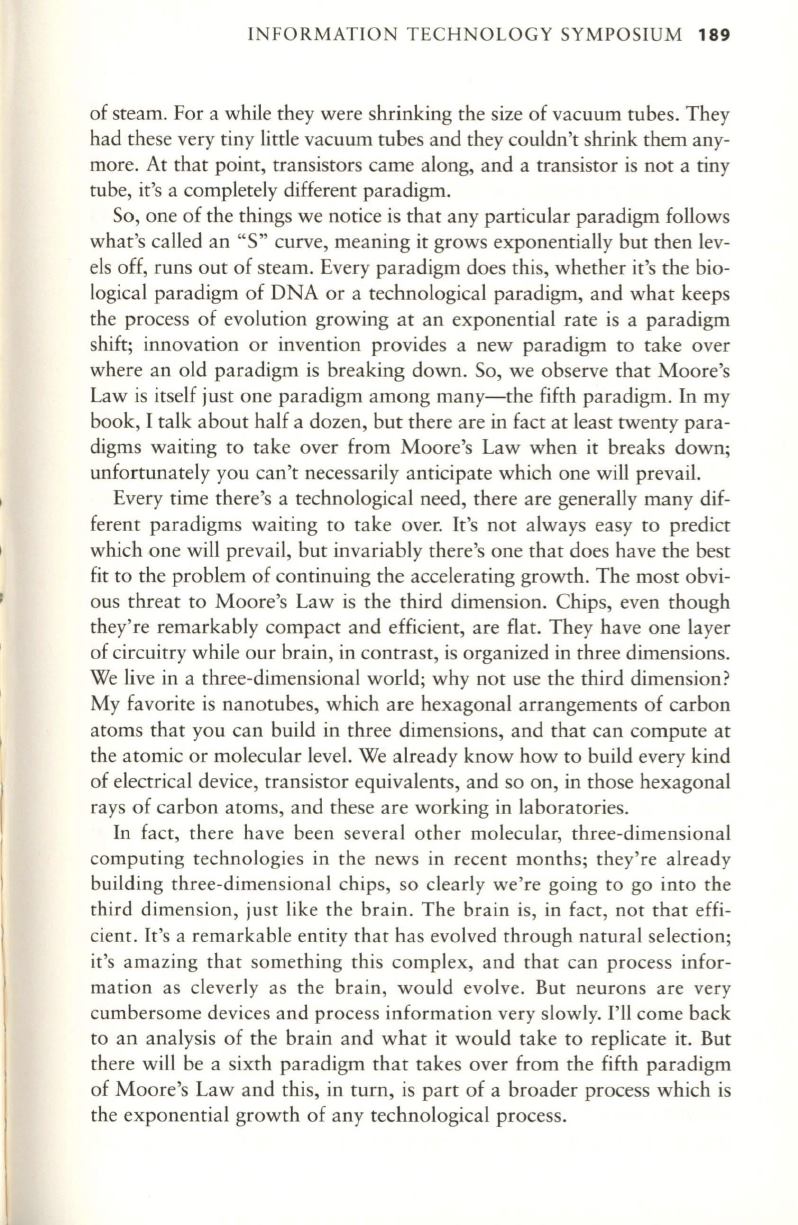
INFORMATION TECHNOLOGY SYMPOSIUM
189
of steam. For a while they were shrinking the size of vacuum tubes. They
had these very tiny little vacuum tubes and they couldn't shrink them any–
more. At that point, transistors came along, and a transistor is not a tiny
tube, it's a completely different paradigm.
So, one of the things we notice is that any particular paradigm follows
what's called an "5" curve, meaning it grows exponentially but then lev–
els off, runs out of steam. Every paradigm does this, whether it's the bio–
logical paradigm of DNA or a technological paradigm, and what keeps
the process of evolution growing at an exponential rate is a paradigm
shift; innovation or invention provides a new paradigm
to
take over
where an old paradigm is breaking down. So, we observe that Moore's
Law is itself just one paradigm among many-the fifth paradigm. In my
book, I talk about half a dozen, but there are in fact at least twenty para–
digms waiting to take over from Moore's Law when it breaks down;
unfortunately you can't necessarily anticipate which one will prevail.
Every time there's a technological need, there are generally many dif–
ferent paradigms waiting to take over. It's not always easy to predict
which one will prevail, but invariably there's one that does have the best
fit to the problem of continuing the accelerating growth. The most obvi–
ous threat to Moore's Law is the third dimension. Chips, even though
they're remarkably compact and efficient, are flat. They have one layer
of circuitry while our brain, in contrast, is organized in three dimensions.
We live in a three-dimensional world; why not use the third dimension?
My favorite is nanotubes, which are hexagonal arrangements of carbon
atoms that you can build in three dimensions, and that can compute at
the atomic or molecular level. We already know how to build every kind
of electrical device, transistor equivalents, and so on, in those hexagonal
rays of carbon atoms, and these are working in laboratories.
In fact, there have been several other molecular, three-dimensional
computing technologies in the news in recent months; they're already
building three-dimensional chips, so clearly we're going to go into the
third dimension, just like the brain. The brain is, in fact, not that effi–
cient. It's a remarkable entity that has evolved through natural selection;
it's amazing that something this complex, and that can process infor–
mation as cleverly as the brain, would evolve. But neurons are very
cumbersome devices and process information very slowly. I'll come back
to
an analysis of the brain and what it would take to replicate it. But
there will be a sixth paradigm that takes over from the fifth paradigm
of Moore's Law and this, in turn, is part of a broader process which is
the exponential growth of any technological process.


